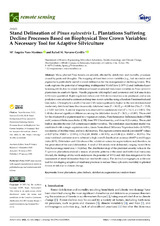Mostrar el registro sencillo del ítem
Stand Delineation of Pinus sylvestris L. Plantations Suffering Decline Processes Based on Biophysical Tree Crown Variables: A Necessary Tool for Adaptive Silviculture
| dc.contributor.author | Varo-Martínez, Mª Ángeles | |
| dc.contributor.author | Navarro Cerrillo, Rafael M. | |
| dc.date.accessioned | 2021-01-28T19:43:27Z | |
| dc.date.available | 2021-01-28T19:43:27Z | |
| dc.date.issued | 2021 | |
| dc.identifier.uri | http://hdl.handle.net/10396/21026 | |
| dc.description.abstract | Many planted Pinus forests are severely affected by defoliation and mortality processes caused by pests and droughts. The mapping of forest tree crown variables (e.g., leaf area index and pigments) is particularly useful in stand delineation for the management of declining forests. This work explores the potential of integrating multispectral WorldView-2 (WV-2) and Airborne Laser Scanning (ALS) data for stand delineation based on selected tree crown variables in Pinus sylvestris plantations in southern Spain. Needle pigments (chlorophyll and carotenes) and leaf area index (LAI) were quantified. Eight vegetation indices and ALS-derived metrics were produced, and seven predictors were selected to estimate and map tree crown variables using a Random Forest method and Gini index. Chlorophylls a and b (Chla and Chlb) were significantly higher in the non-defoliated and moderately defoliated trees than in severely defoliated trees (F = 14.02, p < 0.001 for Chla; F = 13.09, p < 0.001 for Chlb). A similar response was observed for carotenoids (Car) (F = 14.13, p < 0.001). The LAI also showed significant differences among the defoliation levels (F = 26.5, p < 0.001). The model for the chlorophyll a pigment used two vegetation indices, Plant Senescence Reflectance Index (PSRI) and Carotenoid Reflectance Index (CRI); three WV-2 band metrics, and three ALS metrics. The model built to describe the tree Chlb content used similar variables. The defoliation classification model was established with a single vegetation index, Green Normalized Difference Vegetation Index (GNDVI); two metrics of the blue band, and two ALS metrics. The pigment contents models provided R2 values of 0.87 (Chla, RMSE = 12.98%), 0.74 (Chlb, RMSE = 10.39%), and 0.88 (Car, RMSE = 10.05%). The cross-validated confusion matrix achieved a high overall classification accuracy (84.05%) and Kappa index (0.76). Defoliation and Chla showed the validation values for segmentations and, therefore, in the generation of the stand delineation. A total of 104 stands were delineated, ranging from 6.96 to 54.62 ha (average stand area = 16.26 ha). The distribution map of the predicted severity values in the P. sylvestris plantations showed a mosaic of severity patterns at the stand and individual tree scales. Overall, the findings of this work underscore the potential of WV-2 and ALS data integration for the assessment of stand delineation based on tree health status. The derived cartography is a relevant tool for developing adaptive silvicultural practices to reduce Pinus sylvestris mortality in planted forests at risk due to climate change. | es_ES |
| dc.format.mimetype | application/pdf | es_ES |
| dc.language.iso | eng | es_ES |
| dc.publisher | MDPI | es_ES |
| dc.rights | https://creativecommons.org/licenses/by/4.0/ | es_ES |
| dc.source | Remote Sensing 13(3), 436 (2021) | es_ES |
| dc.subject | Forest plantations | es_ES |
| dc.subject | Pine dieback | es_ES |
| dc.subject | Defoliation | es_ES |
| dc.subject | Segmentation | es_ES |
| dc.subject | Random forest | es_ES |
| dc.title | Stand Delineation of Pinus sylvestris L. Plantations Suffering Decline Processes Based on Biophysical Tree Crown Variables: A Necessary Tool for Adaptive Silviculture | es_ES |
| dc.type | info:eu-repo/semantics/article | es_ES |
| dc.relation.publisherversion | http://dx.doi.org/10.3390/rs13030436 | es_ES |
| dc.relation.projectID | Gobierno de España. CGL2017-86161-R | es_ES |
| dc.relation.projectID | Junta de Andalucía. UCO-1265298 | es_ES |
| dc.rights.accessRights | info:eu-repo/semantics/openAccess | es_ES |

